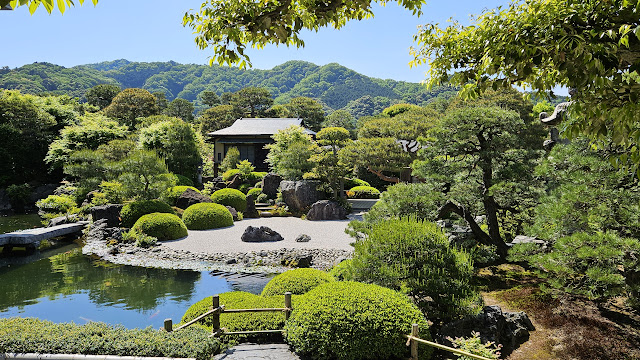Another early start. John's hanging out for a bit of a lie-in. We were on board the 7:48am train for the 20-minute trip to Yasugi, then it was a 40-minute wait to jump on the connecting free shuttle bus to Adachi. The focus this morning was to visit the Adachi Museum of Art which houses many paintings by some of Japan's more modern painters. Of more interest to us, however, were the zen-style gardens attached to the museum. These gardens are consistently ranked the No. 1 in all of Japan out of over 1000 special gardens. It is a museum of art, but most people go there for its gardens.
 |
| Lacquerware writing box at Adachi Museum of Art |
The gardens were indeed amazing. The dry landscape garden was the most impressive to us, but there were also moss, waterfall and pond gardens. They are specifically designed to provide a feeling of harmony, a graceful aesthetic and to blend into the mountain backdrop. Manicured to the extreme, we saw a group of perhaps 8 gardeners concentrating on one area, pruning, picking up leaves and generally keeping the environment absolutely pristine.
 |
| Adachi Museum of Art dry landscape garden |
 |
| Pond garden |
Because the gardens are so strictly maintained, it was a little disappointing that they could only be viewed from behind bamboo barriers, or behind glass. Because of this, we felt rather disconnected from the action, but after all, this is a zen garden and therefore designed for contemplation and reflection.
The gardens were indeed extraordinary, but I've got to say I prefer those gardens we have seen elsewhere in Japan where it's possible to walk along trails - stroll gardens - and be greeted by unfolding views, get really close to the moss, flower blooms, carp in the water or whatever. They engender a far more enveloping feeling, one I have come to love.
So, quite surprisingly, we had 'done' the gardens and museums within just an hour, so could get an earlier shuttle and train back to Matsue than expected. We had an hour to spare before catching the next bus, this time to a another garden complex. Yuushien Gardens are well-known for their peonies, and we were hoping they might be in flower given we are in the right season.
It was a 45 minute trip by bus, out over a causeway onto an island in the middle of the Nakaumi Lake. Indeed it was well worth the excursion. This turned out to be a stroll garden, and because of this we found it entrancing. Only a few peonies were in flower but there were many of the larger deciduous azaleas in full bloom. All the small-leaved azaleas had finished flowering and were tightly pruned back.
It was a pleasure to wander along the paths. The sunny weather provided some lovely plays of light and shadow. The garden had it all - a vermillion wooden bridge, rock bridges, mosses, maples, bonsai, waterfalls, lakes, carp, and more. We had plenty of time to quietly enjoy the atmosphere and take far too many photos. I'm keen to do another cross-stitch of a Japanese garden so we tried to tried to capture a photo which might provide the template.
 |
| Yuushien Gardens |
Back to our hotel by 5pm we had a short rest before trying a nearby eatery for dinner. We were keen to have an okonomiyaki, having eaten a number on our previous visits to Japan, and since then some relatively poor versions in the kitchen at home.
It proved delicious. Patrons sit at a large iron hotplate, perhaps 70cm by 3m, with the chef on the other side. I'll try and describe how our ones were made. The chef starts by pouring a thin batter circle onto the hot plate, perhaps 25 cm across. Onto this goes a vast amount, maybe 3 cm deep, of finely shredded cabbage, then grated carrot, and tempura scraps. He then pours a little more batter over it to bind it. Next a few rashers of bacon and, for mine, some chopped up squid and a few prawns. This sits cooking for a long time, a good 5 minutes or more. It then gets turned for another few minutes cooking and he introduces a little dashi (bonito and kelp broth) into it to help the veges soften. An egg is cracked onto the hot plate and spread out and the whole lot is dropped onto the egg. After a few moments he flips it back so the batter base is on the bottom again, and then dresses it. There are any number of variants of toppings - ours were quite simple with a sweet brown sauce smeared over the lot, some whitish powder and some dried seaweed flakes. Variations include adding a zig-zag of mayonnaise, more sauces, and bonito flakes.
The okonomiyaki is slid over the hotplate onto a slightly cooler stainless edge band in front of the patrons, who chop it into manageable pieces with a little metal spatula and put it on a small plate to eat. It was delicious. Just the ticket when you have had your fill of noodles and rice.
 |
| Our okonomiyaki joint |




